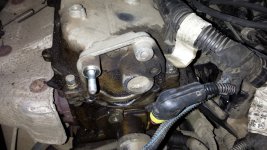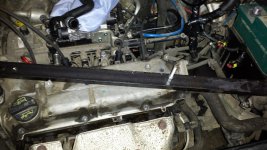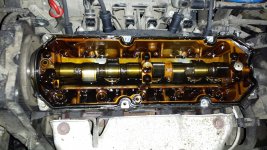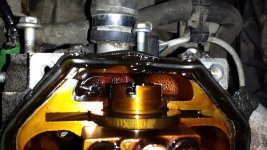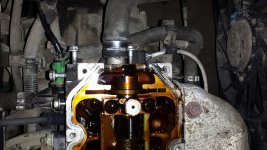Hello,
I'm pretty new around here, so hello to all of you.
Now, about the subject: Fiat Panda engine, 1242 8v, 44kW, production 2007, engine code 169A4.000. The car have now about 70.000 miles on it (115.000 km)
I'm not quite a mechanic, but I like to fix something here and there; I own the car from brand new, so let's say I'm somehow attached to it.
Problem: I think the picture talk by itself.
The valve cover gasket was improperly mounted from brand new. The leak was so small, that I wouldn't notice from a oil change to another. But, good enough for the oil to accumulate in the engine coolant sensor coupling, which caused erratic problems (which hopefully now are gone, after I've cleaned the leak).
My problem: I can't remove the valve cover. It is "the new" model, not the one with 4 screws. This one have 8 screws, plus 3 on the timing belt upper-cover, and another 3 on the coils holder. With these screw removed, I can't move the cover.
Now, either the cover is stuck, or I am missing something.
A mechanic suggested that he must do the timing belt too, in order to remove the cover. Is he right? It is really needed to open everything there? or just insist on cover removing, as "it should pop" ?
Suggestions, please ...
Thank you.
I'm pretty new around here, so hello to all of you.
Now, about the subject: Fiat Panda engine, 1242 8v, 44kW, production 2007, engine code 169A4.000. The car have now about 70.000 miles on it (115.000 km)
I'm not quite a mechanic, but I like to fix something here and there; I own the car from brand new, so let's say I'm somehow attached to it.
Problem: I think the picture talk by itself.
The valve cover gasket was improperly mounted from brand new. The leak was so small, that I wouldn't notice from a oil change to another. But, good enough for the oil to accumulate in the engine coolant sensor coupling, which caused erratic problems (which hopefully now are gone, after I've cleaned the leak).
My problem: I can't remove the valve cover. It is "the new" model, not the one with 4 screws. This one have 8 screws, plus 3 on the timing belt upper-cover, and another 3 on the coils holder. With these screw removed, I can't move the cover.
Now, either the cover is stuck, or I am missing something.
A mechanic suggested that he must do the timing belt too, in order to remove the cover. Is he right? It is really needed to open everything there? or just insist on cover removing, as "it should pop" ?
Suggestions, please ...
Thank you.


